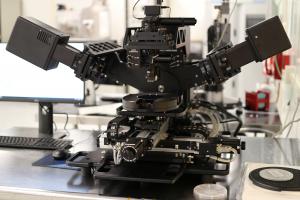TRAINING
For training, please contact the Tool Manager(s). Training takes place in the cleanroom.
Some tool restrictions on high vapor pressure materials may apply.
Spectroscopic ellipsometry is a noninvasive technique that measures the changes in the polarization state (Ψ and Δ) of light reflecting from a substrate. From these parameters, thickness as well as optical properties of thin films and bulk material are determined. Spectroscopic ellipsometry is used for characterization of all types of materials: dielectrics, semiconductors, metals, organics, multilayers, doped films and more. It can characterize optical constants, multilayer thicknesses, composition, crystallinity, surface and interfacial roughness, anisotropy/birefringence, constituent and void fractions, bandgap and electronic transitions of a wide variety of thin films and thin film multilayers.
The Woollam RC2 Spectroscopic Ellipsometer has the same spectral range as the Woollam WVASE ellipsometer, 193-1690 nm, with a number of significant improvements:
- Dual Rotating Compensator (D-RCE) design with achromatic retarder enables acquisition of all 16 elements of the Mueller matrix, for materials that are both depolarizing and anisotropic, where the optical response changes with the sample orientation. Examples of anisotropic materials include quantum wells, some semiconductor oxides, porous silicon, thick liquid crystals, organic polymers for nonlinear optics, aluminum nitride and sol–gel thin films.
- All wavelengths are acquired simultaneously so the minimum data acquisition time is approximately 0.3 seconds; typical data acquisition times are 1 to 5 sec instead of tens of minutes for the WVASE
- Automated motorized tip-tilt alignment of samples instead of manual alignment
- Automated sample height (Z) alignment
- Motorized horizontal sample stage for automated mapping of film properties over a 200 mm × 200 mm area
- A multi-seat license for CompleteEASE software for data acquisition & analysis can be used for offline data analysis and for material model transfer to and from the M-2000 in situ ellipsometer. CompleteEASE includes new thickness pre-fit and B-Spline fitting methods and automatic comparisons of models with and without index grading and/or surface roughness.
- A camera to view the light beam location on the sample.

